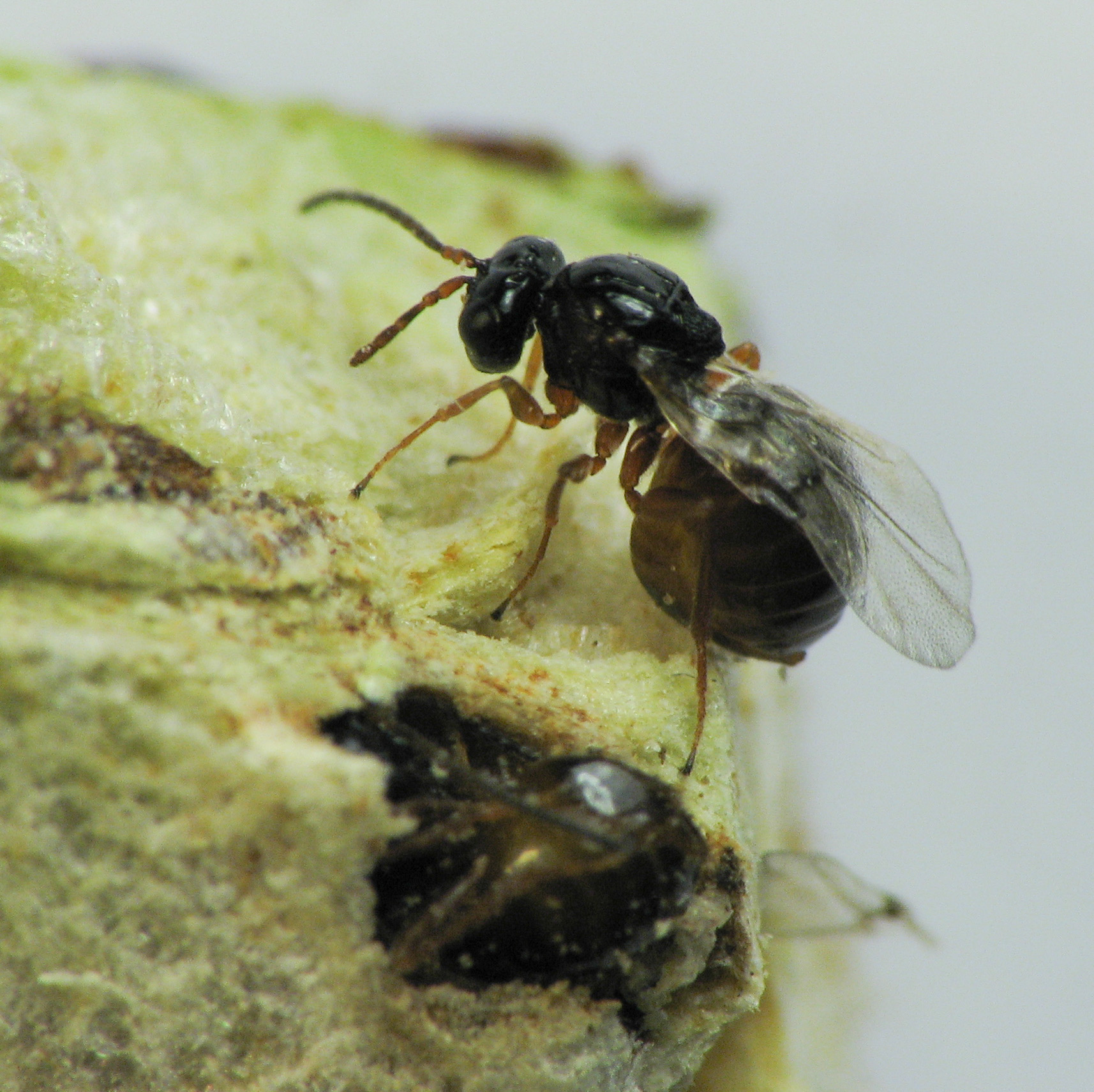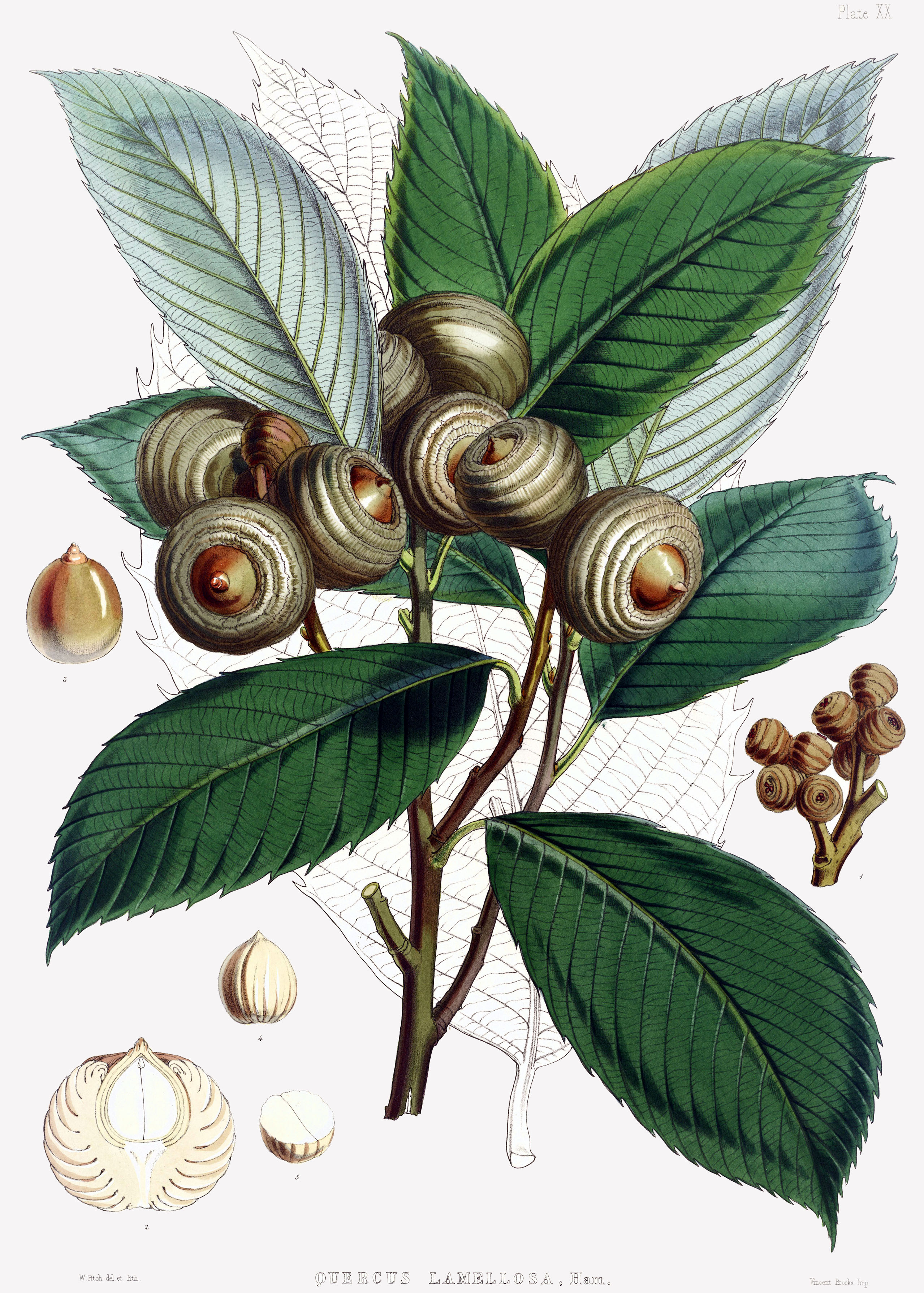|
Callirhytis Seminator
''Callirhytis seminator'', the wool sower, is a species of gall wasp in the family Cynipidae. The adult wasps are about 1/8" in length and dark brown in color. The larvae are white and fat and have no legs. The wasps only lay eggs on white oak trees and only in the spring. They lay the egg in a gall, a round, white structure resembling a cotton ball. It starts out white and later changes color. The larvae develop inside the gall. If pulled open, the gall will appear to have seedlike structures inside it. These structures are actually hard plant material. Gall wasps have a two-generation alternating cycle: One generation produces stem galls, and the wasps that emerge from that stem gall mature and lay their own eggs in leaf galls. The wasps that emerge from the leaf gall mature and produce stem galls. Scientists do not know what the alternate wool sower wasp gall looks like. The wasps neither sting humans nor occur in such numbers as to damage the white oak trees. Ref ... [...More Info...] [...Related Items...] OR: [Wikipedia] [Google] [Baidu] |
Thaddeus William Harris
Thaddeus William Harris (November 12, 1795 – January 16, 1856) was an American entomologist and librarian. His focus on insect life cycles and interactions with plants was influential in broadening American entomological studies beyond a narrow taxonomic approach. He was an early agricultural entomologist and served as a mentor and role model for others in this new field. For 25 years Harris served as the librarian of Harvard University where oversaw the rapid growth of the library and introduced one of the earliest American library card catalogs.Elliott 2000 Life and career Thaddeus William Harris was born in Dorchester, Massachusetts on November 12, 1795. His father, Thaddeus Mason Harris, was a Unitarian minister who served at the church on Meeting House Hill and had also for a time served as librarian of Harvard. Harris himself received his undergraduate degree at Harvard in 1815, and then went on to study medicine there, receiving his M.D. in 1820. He went into medical pr ... [...More Info...] [...Related Items...] OR: [Wikipedia] [Google] [Baidu] |
Gall Wasp
Gall wasps, also incorrectly called gallflies, are hymenopterans of the family Cynipidae in the wasp superfamily Cynipoidea. Their common name comes from the galls they induce on plants for larval development. About 1,300 species of this generally very small creature (1–8 mm) are known worldwide, with about 360 species of 36 different genera in Europe and some 800 species in North America. Features Like all Apocrita, gall wasps have a distinctive body shape, the so-called Petiole (insect anatomy), wasp waist. The first abdominal tergum (the propodeum) is conjoined with the Thorax (insect anatomy), thorax, while the second abdominal segment forms a sort of shaft, the Petiole (insect anatomy), petiole. The petiole connects with the gaster (insect anatomy), gaster, which is the functional abdomen in apocritan wasps, starting with the third abdominal segment proper. Together, the petiole and the gaster form the metasoma, while the thorax and the propodeum make up the mesosoma ... [...More Info...] [...Related Items...] OR: [Wikipedia] [Google] [Baidu] |
Cynipidae
Gall wasps, also incorrectly called gallflies, are hymenopterans of the family Cynipidae in the wasp superfamily Cynipoidea. Their common name comes from the galls they induce on plants for larval development. About 1,300 species of this generally very small creature (1–8 mm) are known worldwide, with about 360 species of 36 different genera in Europe and some 800 species in North America. Features Like all Apocrita, gall wasps have a distinctive body shape, the so-called wasp waist. The first abdominal tergum (the propodeum) is conjoined with the thorax, while the second abdominal segment forms a sort of shaft, the petiole. The petiole connects with the gaster, which is the functional abdomen in apocritan wasps, starting with the third abdominal segment proper. Together, the petiole and the gaster form the metasoma, while the thorax and the propodeum make up the mesosoma. The antennae are straight and consist of two or three segments. In many varieties, the backside ... [...More Info...] [...Related Items...] OR: [Wikipedia] [Google] [Baidu] |
White Oak
The genus ''Quercus'' contains about 500 species, some of which are listed here. The genus, as is the case with many large genera, is divided into subgenera and sections. Traditionally, the genus ''Quercus'' was divided into the two subgenera ''Cyclobalanopsis'', the ring-cupped oaks, and ''Quercus'', which included all the other sections. However, a comprehensive revision in 2017 identified different relationships. Now the genus is commonly divided into a subgenus ''Quercus'' and a sugenus ''Cerris'', with ''Cyclobalanopsis'' included in the latter. The sections of subgenus ''Quercus'' are mostly native to the New World, with the notable exception of the white oaks of sect. ''Quercus'' and the endemic Quercus pontica. In contrast, the sections of the subgenus ''Cerris'' are exclusively native to the Old World. Legend Species with evergreen foliage ("live oaks") are tagged '#'. Species in the genus have been recategorized between deciduous and evergreen on numerous occasions, alt ... [...More Info...] [...Related Items...] OR: [Wikipedia] [Google] [Baidu] |
Insects Described In 1841
Insects (from Latin ') are pancrustacean hexapod invertebrates of the class Insecta. They are the largest group within the arthropod phylum. Insects have a chitinous exoskeleton, a three-part body (head, thorax and abdomen), three pairs of jointed legs, compound eyes and one pair of antennae. Their blood is not totally contained in vessels; some circulates in an open cavity known as the haemocoel. Insects are the most diverse group of animals; they include more than a million described species and represent more than half of all known living organisms. The total number of extant species is estimated at between six and ten million; In: potentially over 90% of the animal life forms on Earth are insects. Insects may be found in nearly all environments, although only a small number of species reside in the oceans, which are dominated by another arthropod group, crustaceans, which recent research has indicated insects are nested within. Nearly all insects hatch from eggs. Insect ... [...More Info...] [...Related Items...] OR: [Wikipedia] [Google] [Baidu] |
Oak Galls
Oak apple or oak gall is the common name for a large, round, vaguely apple-like gall commonly found on many species of oak. Oak apples range in size from in diameter and are caused by chemicals injected by the larva of certain kinds of gall wasp in the family Cynipidae. The adult female wasp lays single eggs in developing leaf buds. The wasp larvae feed on the gall tissue resulting from their secretions, which modify the oak bud into the gall, a structure that protects the developing larvae until they undergo metamorphosis into adults. Considerable confusion exists in the general literature between the oak apple and the oak marble gall. The oak marble is frequently called the oak apple due to the superficial resemblance and the preponderance of the oak marble gall in the wild. Other galls found on oak trees include the oak artichoke gall and the acorn cup gall, but each of these has its own distinctive form. Some common oak-apple-forming species are the ''Biorhiza ... [...More Info...] [...Related Items...] OR: [Wikipedia] [Google] [Baidu] |



